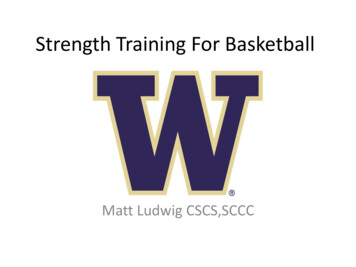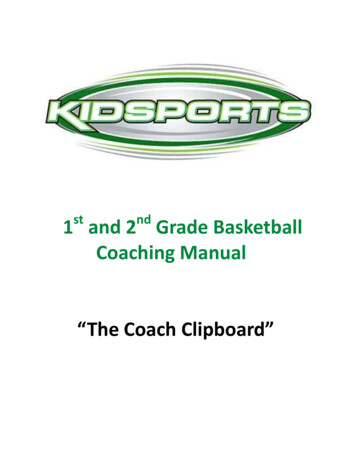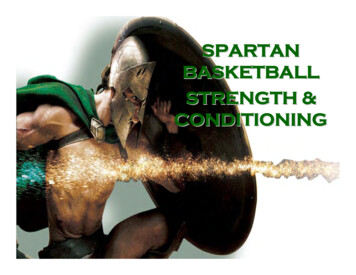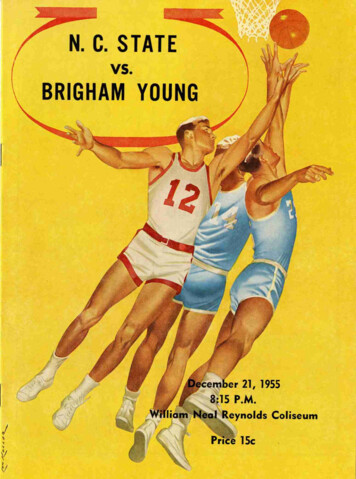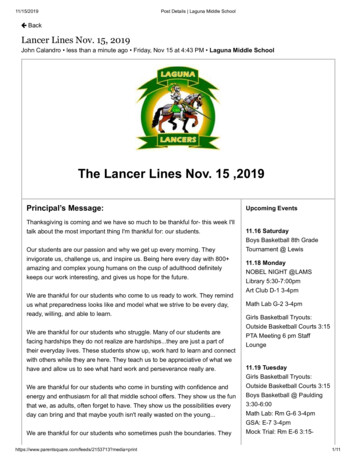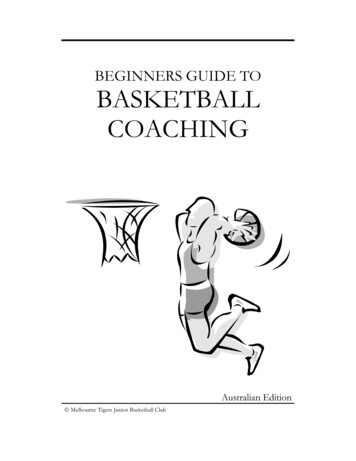
Transcription
BEGINNERS GUIDE TOBASKETBALLCOACHINGAustralian Edition Melbourne Tigers Junior Basketball Club
1. Who Me . a Coach?If you’re like most junior basketball coaches, you were recruited fromthe ranks of concerned parents, sport enthusiasts or communityvolunteers. And like many rookie and veteran coaches, you probablyhave had little formal instruction on how to coach. But when the callwent out for coaches to assist with the basketball program, youanswered because you like children, enjoy basketball, are communityminded and perhaps are interested in starting a coaching career.I want to Help, But Your initial coaching assignment may be difficult. Like manyvolunteers, you may not know everything there is to know aboutbasketball, nor about how to work with children between the ages of 6and 14. Relax, this manual will help you learn the basics for coachingbasketball effectively. In the coming pages you’ll find the answers tosuch common questions as the following: What tools do I need to be a good coach? How can I best communicate with my players? How do I go about teaching sport skills? What can I do to promote safety? What actions do I take when someone is injured?
What are the basic rules, skills, and strategies of basketball? What practice drills will improve my basketball skills?Before answering these questions, let’s take a look at what’sinvolved in being a coach.Am I a Parent or a Coach?Many coaches are parents, but the two roles should not be confused.As a parent you are responsible only to yourself and your child; as acoach you are responsible to the organisation, all the players on theteam, (including your child), their parents, and yourself.When you assume these additional responsibilities as a coach, your sonor daughter may not understand why you behave differently on thebasketball court than you do at home. To avoid problems, take thefollowing steps when coaching your child. Ask your child if he or she wants you to coach the team Explain why you wish to be involved with the team. Discuss with your child your new responsibilities and how they willaffect your relationship when coaching. Limit your "coach" behaviour to those times when you are in acoaching role. Avoid parenting during practice or game situations to keep yourrole clear in your child's mind.
Reaffirm your love for your child irrespective of his or herperformance on the basketball court.What are my responsibilities as aCoach?A coach assumes the responsibility of doing everything possible toensure that the youngsters on his or her team will have an enjoyableand safe sporting experience while they learn sport skills. If you’reever in doubt about your approach, remind yourself that “fun andfundamentals” are most important.Provide an Enjoyable Experience.Sport should be fun. Even if nothing else is accomplished, makecertain your players have fun. Take the fun out and sport and you’lltake the kids out of sport.Children enter sport for a number of reasons( eg. to meet and play withother children, to develop physically, to learn skills, but their majorobjective is to have fun. Help them satisfy this goal by injectinghumour and variety into your practices. Also, make games nonthreatening, enjoyable experiences for your players. Such an approachwill increase their desire for future participation, which should be theprimary goal of youth sport. Unit 2 will help you learn how to satisfyyour players’ yearning for fun and keep winning in perspective. And,unit 3 will describe how to communicate this perspective effectively tothem.
Provide a Safe Experience.You are responsible for planning and teaching activities in such a waythat the progression between activities minimises risks (see chapters 4and 5). You also should ensure that the facility at which your teampractices and plays, and the equipment team members use, are free ofhazards. Finally, you need to protect yourself from any legal liabilityissues that might arise from your involvement as a coach.Teach Basic Basketball Skills.In becoming a coach, you take on the role of educator. You must teachyour players the fundamental skills and strategies necessary for successin basketball. That means that you need to “go to school.” You’ll alsofind that you are better able to teach the basketball skills and strategiesyou do know if you plan your practices. Unit 4 of this manual providesguidelines for effective practice planning.If you don’t know the basics of basketball now, you can learn them byreading the second half of this manual. And even if you knowbasketball as a player, do you know how to teach it? This will helpyou get started. Furthermore, many valuable basketball books areavailable.Who Can Help?Veteran coaches in your club are an especially good source ofinformation and assistance. You can also learn a great deal byobserving top coaches in practices and games. You might even ask afew of the coaches you respect most to lend a hand with a couple ofyour practices. These coaches have experienced the same emotionsand concerns you are facing; their advice and feedback can beinvaluable as you work through your first seasons of coaching. Youcan get additional help by attending basketball clinics, readingbasketball publications, and studying instructional videosThe VBA has videos and a coaching director with information that canhelp you. Please contact the VBA office Ph (03) 9927 6666.Your coaching co-ordinator and administrator has put away manybooks videos and training session notes. Please contact them theymight also be able to help.Coaching basketball is a rewarding experience. And, just as you wantyour players to learn and practice to be the best they can be, learn allyou can about coaching so you can be the best basketball coach youcan be.
2. What Tools do I Needto Coach?Have you purchased the traditional coaching tools - things likewhistles, coaching clothes, basketball shoes, and a clipboard? They’llhelp you coach, but to be a successful coach you’ll need five othertools that cannot be bought. These tools are available only throughself-examination and hard work, but they’re easy to remember with theacronym COACH:COACH hensionComprehension of the rules, skills, tactics of basketball is required. Itis essential that you understand the basic elements of the sport. Toassist you in learning about the game, the second half of this manualdescribes the rules, skills and tactics of basketball, and suggests how toplan for the season and individual practices. In the basketball-specific
section of this guide, you'll also find a variety of drills to use indeveloping young players' basketball skills.To improve your comprehension of basketball, take the followingsteps: Read the sport-specific section of this manual Consider reading other basketball coaching books. Attend basketball coaches' clinics. Talk with other, more experienced basketball coaches. Watch some high standard junior basketball games: Watch basketball games on televisionIn addition to having basketball knowledge, you must implementproper training and safety methods so your players can participate withlittle risk of injury. Even then, sport injuries will occur and, more oftenthan not, you’ll be the first person responding to your player’s injuries.Therefore, make sure you understand the basic emergency careprocedures described in Chapter 5. Also read in that unit how to handlemore serious sport injury situation.OutlookThis coaching tool refers to your perspective and goals what you areseeking as a coach. The most common coaching objectives are: (a) tohave fun (b) to help players develop the physical, mental, and socialskills, and (c) to win. Thus outlook involves the priorities you set,your planning, and your vision for the future.To work successfully with children in a sport setting, you must haveyour priorities in order. In just what order do you rank the importanceof fun, development, and winning?Answer the following questions to examine your objectives.Of which situation would you be most proud?a) Knowing that each participant enjoyed playing basketball.b) Seeing that all players improved their basketball skills.c) Winning the premiership for your grade.Which statement best reflects your thoughts aboutsport?a) If it isn't fun, don't do it.b) Everyone should learn something every day.c) Sport isn't fun if you don't win
How would you like your players to remember you?a) As a coach who was fun to play for.b) As a coach who provided a good base of fundamental skills.c) As a coach who had a winning record.Which would you most like to hear a parent of achild on your team say?a) Billy really had a good time playing basketball this year.b) Susie learned some important lessons playing basketball this year.c) Ronnie played on the team that won the B1 Grand final this year.Which of the following would be the most rewardingmoment of your season?a) Having your team not want to stop playing even after practice isover.b) Observing your players finally master the skill of dribbling withoutlooking at the ball.c) Winning the Grand final.Look over your answers. If you most often selected “a” responses,then having fun is important to you. A majority of “b” answerssuggests that skill development is what attracts you to coaching. Andif “c” was your most frequent response, winning is tops on your list ofcoaching priorities.
Most coaches say fun and development are most important, but whenactually coaching, some coaches emphasise - indeed overemphasise winning. You too will face situations that challenge you to keepwinning in its proper perspective.During such moments you'll have to choose between emphasising yourplayers' development or winning. If your priorities are in order, yourplayers' well-being will take precedence over your team's win-lossrecord every time.Take the following actions to better define your outlook: Determine your priorities for the season. Prepare for situations that challenge your priorities Set goals for yourself and your players that are consistent with thosepriorities. Plan how you and your players can best attain those goals. Review your goals frequently to be sure that you are staying ontrack.It is particularly important for coaches to permit all young athletes toparticipate. Each youngster should have an opportunity to developskills and have fun - even if it means sacrificing a win or two duringthe season. After all, wouldn’t you prefer losing a couple of games tolosing a couple of players’ interest in sport?Remember that the challenge and joy of sport is experienced throughstriving to win, not through winning itself. Players who aren’t allowedoff the bench are denied the opportunity to strive to win. And hereinlies the irony: A Coach who allows all of his or her players toparticipate and develop skills will, in the end, come out on top.The following motto summarises in four words all you need toremember when establishing your coaching prioritiesAthletes first, winning secondAthletes don't run to win - they run to runThese motto recognise that striving to win is an important, even vitalpart of sport. But it emphatically states that no efforts in striving towin should be made at the expense of athletes’ well-being,development and enjoyment.AffectionThis is another vital tool you will want to have in your coaching Kit: agenuine concern for the young people you coach. Affection involveshaving a love for children, a desire to share with them your love and
knowledge of sport, and the patience and understanding that allowseach individual playing for you to grow from his or her involvement inbasketball.Successful coaches have a real concern for the health and welfare oftheir players. They care that each child on the team has an enjoyableand successful experience. They have a strong desire to work withchildren and be involved in their growth. And they have the patienceto work with those who are slower to learn or less capable ofperforming. If you have such qualities or are willing to work hard todevelop them, then you have the affection necessary to coach youngathletes.There are many ways to demonstrate your affection and patience,including the following: Make an effort to get to know each player on your team. Treat each player as an individual. Empathise with players' trying to learn new and difficult basketballskills. Treat players as you would like to be treated under similarcircumstances. Be in control of your emotions. Show your enthusiasm for being involved with your team. Keep an up-beat and positive tone in all of your communications.CharacterYoungsters learn by listening to what adults say. But they learn evenmore by watching the behaviours of certain important individuals. Asa coach, you are likely to be a significant figure in the lives of yourplayers. Will you be a good role model?Having good character means modelling appropriate behaviours forsport and life. That means more than just saying the right things.What you say and what you do must match. There is no place incoaching for the “Do as I say, not as I do” philosophy. Be in controlbefore, during, and after all games and practices. And don’t be afraidto admit that you were wrong. No one is perfect!Consider the following steps to being a good role model: Take stock of your strengths and weaknesses. Build on your strengths. Set goals for yourself to improve upon those areas you would notlike to see mimicked. If you slip up, apologise to your team and to yourself. You’ll dobetter next time
HumourHumour is often overlooked as a coaching tool. For our use if meanshaving the ability to laugh at yourself and with your players duringpractices and games. Nothing helps balance the tone of a serious, skilllearning session like a chuckle or two. And a sense of humour puts inperspective the many mistakes your young players will make. So don’tget upset over each miscue or respond negatively to erring players.Allow your players and yourself to enjoy the “ups” and don’t dwell onthe “downs.”Here are some tips for injecting humour into your practices. Make practices fun by including a variety of activities. Keep all players involved in drills and scrimmages. Consider laughter by your players a sign of enjoyment, not a lack ofdiscipline. SMILE!
Where do you stand?Not at all1Somewhat32Very much so54Comprehension1.Could you explain the rules of basketball to other parents withoutstudying for a long time?Answer:2.2345Do you know how to organise and conduct safe basketballpractices?Answer:3.112345Do you know hoe to provide first aid for most common, minorsport injuriesAnswer:12345Your Comprehension Score (Summation of 1, 2 & 3)Outlook4.Do you have winning in its proper perspective when you coach?Answer:5.234545Do you plan for every meeting and practice?Answer:6.1123Do you have a vision of what you want your players to be able todo by the end of the season?Answer:12345Your Outlook Score (Summation of 4,5 & 6)Affection7.Do you enjoy working with children?Answer:8.2345Are you patient with youngsters learning new skills?Answer:9.11234545Are you able to show your players that you care?Answer:123Your Affection Score (Summation of 7, 8 & 9)
Character10. Are your words and behaviour consistent with each other?Answer:123454511. Are you a good model for your players?Answer:12312. Do you keep negative emotions under control before, during, andafter games?Answer:12345Character Score (Summation of 10, 11 & 12)Humour13. Do you usually smile at your players?Answer:1234523454514. Are your practices fun?Answer:115. Are you able to laugh at your mistakes?Answer:123Your Humour Score (Summation of 13, 14 & 15)You should score at least 10 on each of the coaching tools. If youdidn’t perhaps you should review this section, but even if you scored15 on each tool, don’t be complacent. Keep learning! Then you’ll bewell equipped with the tools you need to coach young athletes.
3. How Should ICommunicate WithMy Players?Now you know the tools needed to COACH: Comprehension, Outlook,Affection, Character, and Humour are essential for effective coaching.Without them, you’d have a difficult time getting started. But none ofthese tools will work if you don’t know how to use them with yourathletes - that requires good communication. This unit examines whatcommunication is and how you can become a more effectivecommunicator-coach.What’s involved in communication?Coaches often believe that communication involved only instructingplayers to do something, but these verbal commands are a very smallpart of the communication process. More than half of what iscommunicated in a message is non-verbal. So remember when you arecoaching, “actions speak louder than words.”
Communication in its simplest form involves two people: a sender anda receiver. The sender can transmit the message verbally, throughfacial expression, and via body language. Once the message is sent, thereceiver must try to determine the meaning of the message. A receiverwho fails to attend or listen will miss part, if not all, of the message.How can I send more effectivemessages?It just is not true that “Sticks and stones may break my bones butwords will never hurt me.” Spoken words can have a strong and longlasting effect. And coaches’ words are particularly influential, becauseyoungsters place great importance on what coaches say. Therefore,whether you are correcting a misbehaviour, teaching a player how todribble the ball, or praising a player for good effort, be positive, but honest; state it clearly and simply; say it loud enough and say it again; and be consistentBe positive, but honestNothing turns people off like hearing someone nag all the time. Youngathletes are similarly discouraged by a coach who gripes constantly.The kids on your team need encouragement because many of themdoubt their ability to play basketball. So look for and tell your playerswhat they did well.
On the other hand, don’t cover up poor or incorrect play with rosywords of praise. Kids know all too well when they have made amistake, and no cheerfully expressed cliché can undo their errors.And, if you fail to acknowledge players’ errors your athletes will thinkyou are a phoney.A good way to handle situations in which you have identified and mustcorrect improper technique is to serve your players a “complimentsandwich”.1. Point out what the athlete did correctly.2. Let the player know what was incorrect in the performance andinstruct him or her how to correct it.3. Encourage the player by re emphasising what he or she did well.State it Clearly and SimplyPositive and honest messages are good, but only if expressed directlyand in words your players understand. “Beating around the bush” is aneffective and inefficient way to send messages verbally. If you ramble,your players will miss the point of your message and probably loseinterest. Below are some tips for saying things clearly. Organise you're thoughts before speaking to your athletes Explain things thoroughly, but don't bore them with long-windedmonologues. Use language that your players can understand. However, avoidtrying to be 'hip' by using their age group's slang words.
Say it Loud Enough and Say It AgainA crowded stadium filled with the sound of bouncing balls can hindercommunication. So talk to your team in a voice that all members canhear and understand. It’s okay, in fact appropriate, to soften your voicewhen speaking to a player individually about a personal problem. Butmost of the time your messages will be for all your players to hear; somake sure they can! A word of caution, however: Don’t dominate thesetting with a booming voice that detracts attention from players’performances.Sometimes what you say, even if stated loud and calmly, won’t sink inthe first time. This may be particularly true with young athletes hearingwords they don’t understand. To avoid boring repetition but still getyour message across, say the same thing in a slightly different way.For instance, you might first tell your players, “Put defensive pressureon your opponent.” Then, soon thereafter, remind them “Play youropponent tight; cut off the dribble, get in the passing lanes, and preventeasy shots.” The second message may get through to some players whomissed it the first time round.Be ConsistentPeople often say things in a way that implies a different message. Forexample, a touch of sarcasm added to the words “way to go” sends anentirely different message than the words themselves suggest. It isessential that you avoid sending such mixed messages. Keep the toneof your voice consistent with the words you use. And don’t saysomething one day and contradict it the next; players will get confused.
Non-Verbal MessagesJust as you should be consistent in the tone of voice and words youuse, you should also keep your verbal and non-verbal messagesconsistent. An extreme example of failing to do this would be shakingyour head, indicating disapproval, while at the same time telling aplayer “nice try.” Which is the player to believe, your gesture or yourwords?Messages can be sent non verbally in a number of ways. Facialexpressions and body language are jut two of the more obvious formsof non-verbal signals that can help you when you coach.Facial ExpressionsThe look on a person’s face is the quickest clue to what he or shethinks or feels. Your players know this, so they will study your face,looking for any sign that will tell them more than the words you say.Don’t try to fool them by putting on a happy or blank “mask.” They’llsee through it, and you’ll lose credibility.
Serious stone-faced expressions are no help to kids who need cues asto how they are performing. They will just assume you’re unhappy ordisinterested. So don’t be afraid to smile. A smile from a coach canboost the confidence of an unsure young athlete. Plus, a smile lets yourplayers know that you are happy coaching them. But don’t overdo itbecause your players won’t be able to tell when you are genuinelypleased by something they’ve done or when you are just “putting on” asmiling face.Body languageHow would your players think you felt if you came to practiceslouched over, with head down and shoulders slumped? Tired? Bored?Unhappy? What would they think if you watched them during acontest with your hands on your hips, jaws clenched, and facereddened? Upset with them? Disgusted at an official? Mad at a fan?Probably some or all of these things would enter your players’ minds.That’s why you should carry yourself in a pleasant, confident, andvigorous manner. Such a posture not only projects happiness with yourcoaching role, it also provides a good example for young players whomay model your behaviour.Physical contact can also be a very important use of body language. Ahandshake, a pat on the head, an arm around the shoulder, or even ahug are effective ways of showing approval, concern, affection, or joyto your players. Some youngsters are receptive to this type of nonverbal message.How Can I Improve My ReceivingSkills?Now let’s examine the other half of the communication process receiving messages. Too often people are very good senders and verypoor receivers of messages; they seem to naturally enjoy hearingthemselves talk more than listening to others. As a coach of youngathletes it is essential that you receive their verbal and non-verbalmessages effectively. You can be a better receiver of your players’messages if you are willing to read about the keys to receivingmessages and then make a strong effort to use them with your players.You’ll be surprised what you’ve been missing.
Attention!First you must pay attention; you must want to hear what others haveto communicate to you. That’s not always easy when you’re busycoaching and have many things competing for your attention. But inone-to-one or team meetings with players, you must really focus onwhat they are telling you, both verbally and non verbally. Not only willsuch focused attention help you catch every word they say, but you’llalso notice their mood and physical state, and you’ll get an idea of theirfeelings toward you and other players on the team.Listen Carefully!How we receive messages from others, perhaps more than anythingelse we do, demonstrates how much we care for the sender and whatthat person has to tell us. If you care little for your players or have littleregard for what they have to say, it will show in how you attend andlisten to them. Check yourself. Do you find your mind wandering towhat you are going to do after practice while one of your players istalking to you? Do you frequently have to ask your players, “What didyou say?” If so, you need to work on your receiving mechanics ofattending and listening. If you find you’re missing the messages yourplayers send, perhaps the most critical question you should askyourself is this: Do I care?
How Do I Put It All Together?So far we’ve discussed sending and receiving messages separately. Butwe all know that senders and receivers switch roles several timesduring an interaction. One person initiates a communication by sendinga message to another person who then receives the message. Thereceiver then switches roles and becomes the sender by responding tothe person who sent the initial message. These verbal and nonverbalresponses are called feedback.Your players will be looking to you for feedback all the time. Theywill want to know how you think they are performing, what you thinkof their ideas, and whether their efforts please you. How you respondwill strongly affect your players. So let’s take a look at a few generaltypes of feedback and examine their possible effects.Providing InstructionsWith young players, much of your feedback will involve answeringquestions about how to play the sport. Your instructive responses tothese questions should include both verbal and non-verbal feedback.The following are suggestions for giving instructional feedback: Keep verbal instructions simple and concise Use demonstrations to provide non-verbal instructional feedback(see chapter 4)
'Walk' players through the skill, or use a slow motion demonstrationif they are having trouble learning.Correcting ErrorsWhen your players perform incorrectly, you need to provideinformative feedback to correct the error - and the sooner the better.And when you do correct errors, keep in mind these two principles:Use negative criticism sparingly, and keep calm.Use Negative Criticism SparinglyAlthough you may need to punish players for horseplay or dangerousactivities by scolding or temporarily removing them from activity,avoid reprimanding players for performance errors. Admonishingplayers for honest mistakes makes them afraid to even try; nothingruins a youngster’s enjoyment of a sport more than a coach who harpson every miscue. So instead, correct your players by using the positiveapproach. They’ll enjoy playing more and you’ll enjoy coaching more.Keep calmDon’t fly off the handle when your players make mistakes. Remember,you’re coaching young and inexperienced players, not pros. You’lltherefore see more incorrect than correct technique and probably havemore discipline problems than you expect. But throwing a tantrumover each error or misbehaviour will only inhibit them or suggest tothem the wrong kind of behaviour to model. Let your players knowthat mistakes aren’t the end of the world; and stay cool!Positive FeedbackPraising players when they have performed or behaved well is aneffective way of getting them to repeat (or try to repeat) that behaviourin the future. and positive feedback for effort is an especially effectiveway to motivate youngsters to work on difficult skills. So rather thanshouting and providing negative feedback to a player who had made amistake, try offering a compliment sandwich.Sometimes just the way you word feedback can make it more positivethan negative. For example, instead of saying, “Don’t shoot the ballthat way,” you might say, “Shoot the ball this way.” Then your playerswill be focusing on what to do instead of what not to do.Coaches, be positive!
Only a very small percentage of well trained coaches’ behaviours arenegative.You can give positive feedback verbally and non verbally. Telling aplayer, especially in front of team mates, that he or she has performedwell, is a great way to increase a kids confidence. And a pat on theback or a handshake can be a very tangible way of communicatingyour recognition of a player’s performance.What Else Do I Need To CommunicateWith?Coaching involves not only sending and receiving messages andproviding proper feedback to players, but also includes interacting withplayers’ parents, fans, game officials, and opposing coaches. If youdon’t communicate effectively with these groups of people, yourcoaching career will be unpleasant, and short-lived. So try thesesuggestions for communicating with each group.ParentsA player’s parents need to be assured that their son or daughter isunder the direction of a coach who is both knowledgeable aboutbasketball and concerned about the youngster’s well-being. You canput their worries to rest by holding a pre-season parent orientationmeeting in which you describe your background and your approach tocoaching.If parents contact you with a concern during the season, listen to themclosely and try to offer positive responses. If you need to communicatewith parents, catch them after a practice, give them a phone call, orsend a note through the mail. Messages sent to parents throughchildren are too often lost, misinterpreted, or forgotten.
Spectators (including parents)The stands probably won’t be overflowing at your games, but that onlymeans that you’ll more easily hear the one or two spectators whocriticise your coaching. When you hear something negative said aboutthe job you’re doing, don’t respond. Keep calm, consider whether themessage had
The VBA has videos and a coaching director with information that can help you. Please contact the VBA office Ph (03) 9927 6666. Your coaching co-ordinator and administrator has put away many books videos and training session notes. Please contact them they might also be able to help. Coaching
